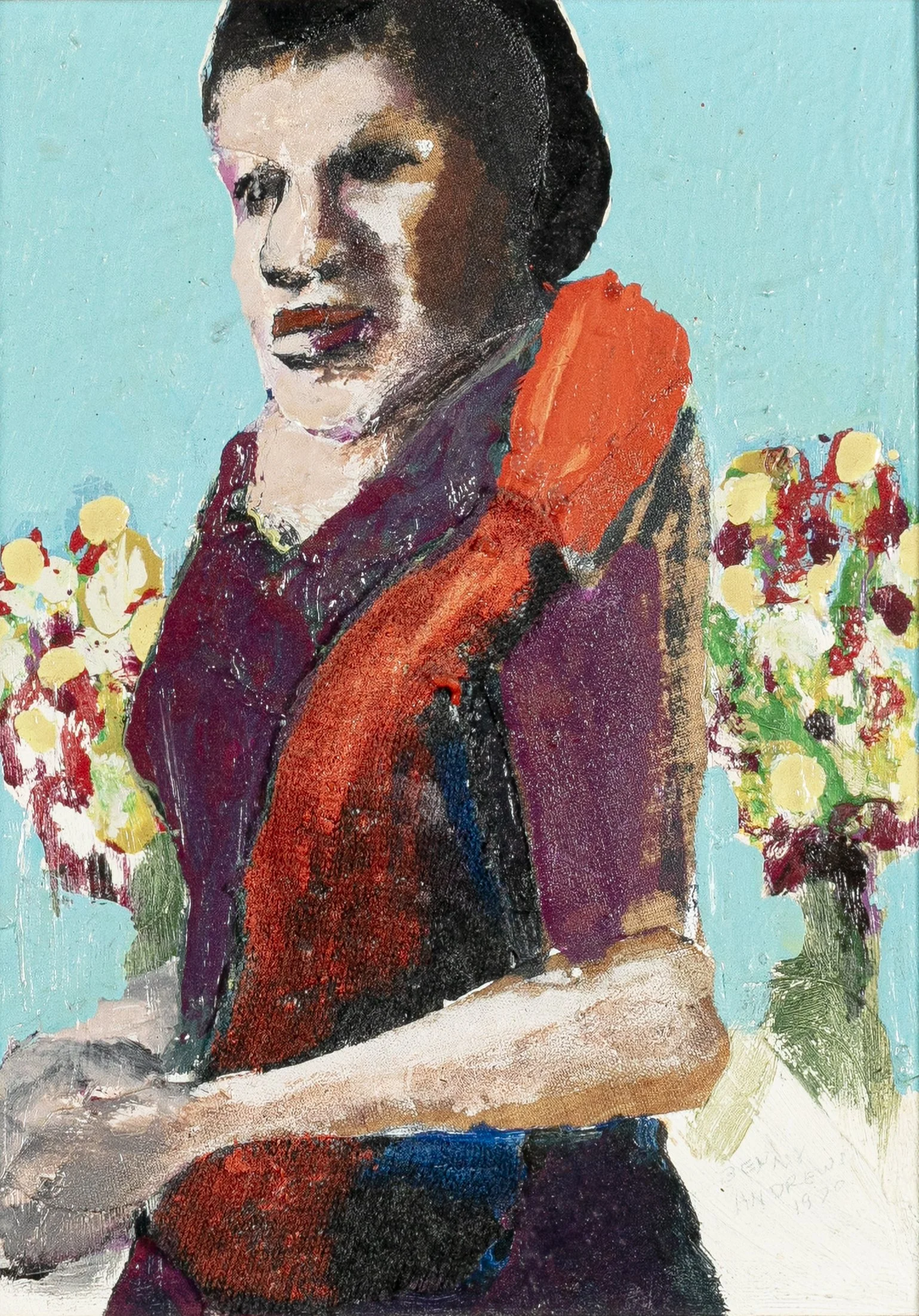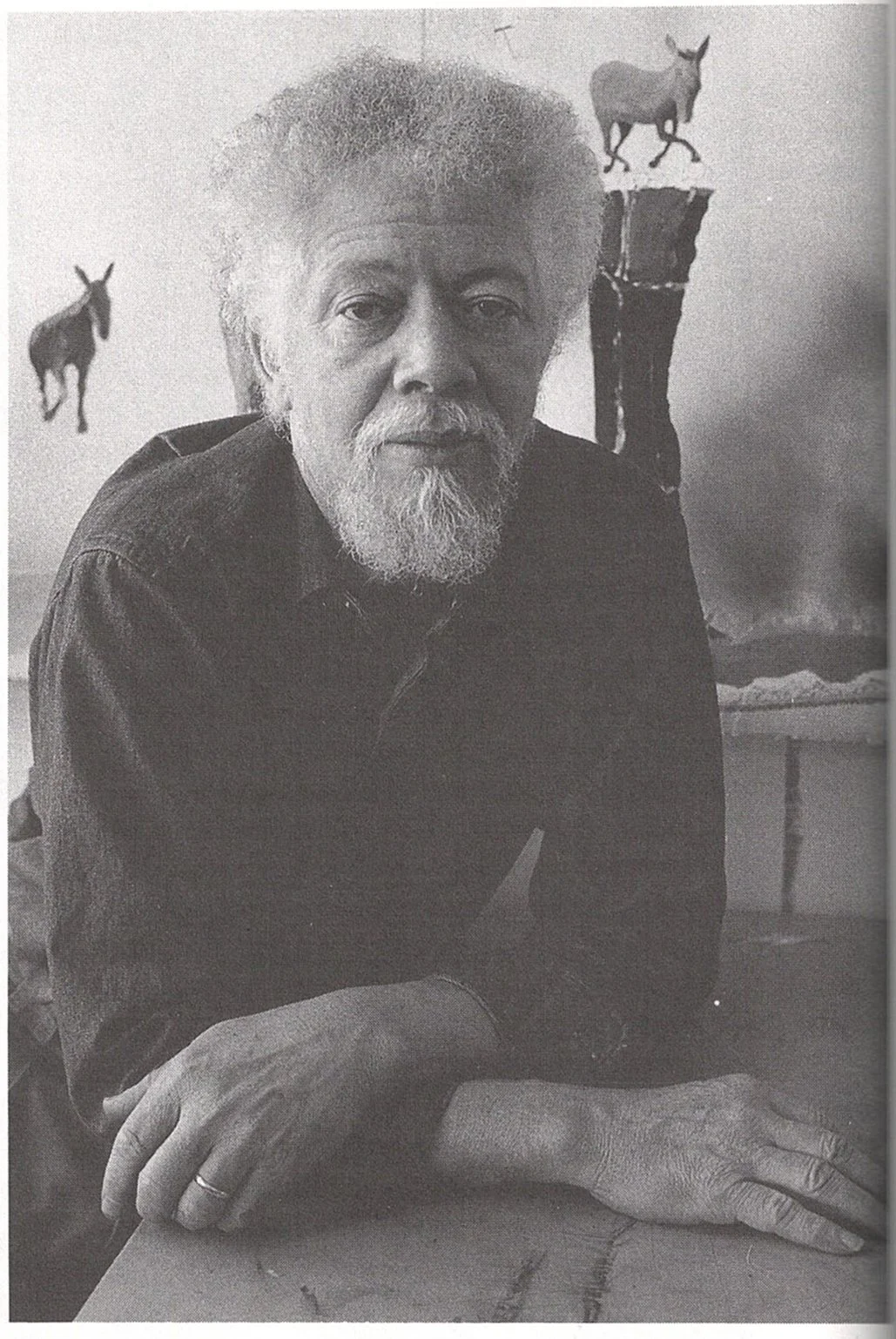
Benny Andrews
(1930-2006)
Growing Up
1973
etching and aquatint on paper
13-5/8 x 11-1/2 inches (image), full margins
signed, dated, titled, and numbered 19/35
From the portfolio, Impressions: Our World, Volume I
Included in the collection of the Smithsonian American Art Museum.
Benny Andrews was born in 1930, the youngest of ten children in a rural community of sharecroppers. Even as a child, it was expected that he work in the fields with his family members, picking cotton. He attended school sporadically, as it fit with his work in the fields. He was able to graduate from high school and went on to attend Fort Valley State College for two years.
After serving in the Korean War with the United States Air Force, he attended the School of the Art Institute in Chicago (1954-58) on a GI Bill, studying with Jack Levine (Social Realist painter and printmaker) and Boris Margo (Russian surrealist). He was generally viewed as an outsider, unyielding to the trends of abstraction at the time he was developing at the Art Institute. His work focused on figurative social commentary depicting the struggles, atrocities, and everyday occurrences in the world, especially in the African American community. In his drawings, paintings, and collages, Andrews continued to pursue representational art, a focus that has been central to his long career.
Andrews moved to the Lower East Side, NY, and befriended figurative expressionists Norman Lewis, Alice Neel, Bob Thompson, Lester Johnson, and Red Grooms. In 1962, he was invited to join the Forum Gallery. Founded in 1961 by Bella Fishko, Forum was established as a gallery of American figurative art. His first solo exhibition received a favorable review in the New York Times, and he went on to exhibit there in 1964 and 1966. He received a John Hay Whitney Fellowship, which he used to return to rural Georgia, and led to his Autobiographical Series.
As his career flourished, he continued to speak out on the inequalities facing African American artists and helped found the Black Emergency Cultural Coalition with fellow artist Cliff Joseph. He spent 29 years teaching art at Queens College and served as the Director of the Visual Arts program, a division of the National Endowment for the Arts (1982-84). In addition, he developed an arts program for use in prisons. His work has garnered both critical acclaim and commercial success. Elected to the National Academy of Design in 1977, he was awarded premier fellowships and exhibited widely in the United States and abroad.
The Bicentennial Series
In the 1970’s, Andrews began work on the monumental Bicentennial Series just as the nation geared up to celebrate the national remembrance. The series was made up of six subseries, which included Symbols, Trash, Circle, Sexism, War, and Utopia, and was meant to represent the response of African-Americans, whose experience over the nation’s first 200 years was very different than the average white American. Andrews remarked that his series was,
“a Black artist’s expression of how he portrays his dreams, experiences, and hopes along with the despair, anger, and depression to so many other Americans’ actions.”
The Studio Museum in Harlem was the first to present part of the series in 1971, and in 1975, the entire series was exhibited at the High Museum of Art (Atlanta, GA); Museum of the National Center of Afro-American Artists (Dorchester, MA); and the Herbert F. Johnson Museum of Art, Cornell University (Ithaca, NY).
The Migrant Series
In 2004, he embarked on another major series that was intended to reflect the significant exoduses in American history including, the routes taken by Dust Bowl migrants during the Great Depression; the forced march of the Cherokee nation on the Trail of Tears; and the displacement of New Orleans residents after the devastating floods of Hurricane Katrina, which disproportionately affected poorer communities of color. Andrews died in 2006, before he could complete the series.
The Red Wrap
1970
oil on board
12 x 9 inches
signed and dated
label verso from ACA Galleries, New York, NY
Selected Exhibitions
Benny Andrews: Symbols and Other Works; Studio Museum in Harlem, 1971
Benny Andrews Retrospective; Loker Gallery, California Museum of Afro-American History & Culture (Los Angeles), 1982
The Collages of Benny Andrews; Studio Museum in Harlem, 1988
American Icons: From Madison to Manhattan, the Art of Benny Andrews, 1948–1997, Morris Museum of Art (Augusta, GA); 1997
Benny Andrews: The Migrant Series; Virginia Museum of Contemporary Art, 2006
Benny Andrews: A Georgia Artist Comes Home; Museum of Contemporary Art of Georgia (Atlanta), 2007
Benny Andrews: There Must Be a Heaven; Michael Rosenfeld Gallery, New York, 2013
The John Lewis Series; National Center for Civil and Human Rights (Atlanta), 2014
Benny Andrews: The Bicentennial Series; Michael Rosenfeld Gallery, 2016
Benny Andrews: Trouble; Ruth Foundation for the Arts (Milwaukee), 2024-25, first major showing to combine the art with Andrews’s archives
